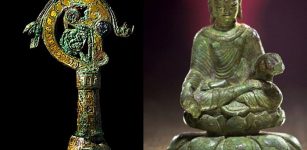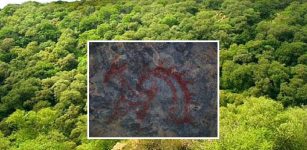Jiangshi – Terrifying Vicious Ancient Chinese Vampire In Disguise
A. Sutherland - AncientPages.com - Myths and legends of Europe, the Americas, China, Japan, and India describe terrible bloodsuckers that may differ in power and individual characteristics. Still, all of them fascinate people, and their vampiric fright knows no borders.
The Jiangshi vampire. Credit: Adobe Stock - FantasyLand86
Influential legends about Jiangshi (or Jiang shi) have long inspired a genre of literature, movies, and video games, especially in Hong Kong and East Asia.
Jiangshi - a genuinely terrifying undead Chinese creature - is described in Chinese legends and folklore as a half-vampire, half-zombie.
Typically, the Jiangshi (hopping vampire or hopping zombie) is depicted as a stiff corpse dressed in the official garments of the Qing dynasty (1644–1912), the last great dynastic empire to rule the region, with many powerful and long-lived rulers.
The belief that the human body can walk and function without personal consciousness or the soul is an idea that has captivated human beings for centuries. This idea is partially implausible as it may be more accurate than one thinks. Within Chinese culture and folklore, strange stories describe a creature known as the Jiangshi. It is believed to be as real, deadly, and terrifying as zombies.
Perhaps the Jiangshi is only an unrealistic, evil creature in Chinese folklore that was used in simple stories to scare children; however, the most remote villages of China blindly believe in the existence of this entity from the underworld and many similar ones.
Are not all the legends based on true events?
According to Chinese legends and folklore, Jiangshi – (‘jiang’ means hard) is a reanimated corpse of a victim of drowning, suicide, hanging, or smothering. These creatures are believed to be particularly vicious, ripping the heads and limbs of their victims.
The Jiangshi is so stiff that it cannot bend its limbs and body, so it moves by hopping, with its arms always outstretched, seeking out living creatures at night and killing them by devouring their ‘qi’ life force. It helps the Jiangshi to survive.
The Jiangshi vampire wears a uniform coat-like robe and round, traditional mandarin hat; they cannot speak and have pale skin, furry green hair, sharp, long claw-like fingernails, and an extremely long tongue.
The Jiangshi is not traditionally equated with the zombie but instead a vampire. During the day, the Jiangshi rests in either a coffin or hides in a dark, chilly cave.
According to one Qing Dynasty scholar, Ji Xiaolan (1724–1805), Jiangshi creatures can be divided into two groups: an old corpse that hasn’t decomposed or a freshly dead body returning to life. When Jiangshi’s corpse is recently deceased, the creature looks almost like an average human. Others, who have been decomposing for some time, have rotting flesh hanging off their yellowing bones. Jiangshi lore is very ancient, and the creature’s existence was taken very seriously by scholars in ancient China who speculated on how Jiangshi was created.
In the meantime, ancient Chinese sincerely believed in dangerous encounters with Jiangshi and tried to protect their homes.
Slats of wood 6 inches high were built under doors in the strange belief that these would keep out hopping zombies. To keep a Jiangshi in place, a slip of yellow paper with a spell written on it was usually also stuck on the corpses.
But the best way to eliminate this terrifying creature was to ask a Taoist priest for help. He was the only one who could balance their life and death with dark and light.
In popular Chinese mythology, reanimated corpses that hop around, killing living creatures to absorb life essence from their victims. Jiangshi is also pronounced Geung si, which is the Cantonese pronounciation for 'Hopping Corpse'. They are said to be created when a person's soul fails to leave the deceased's body.
The myth of "The Corpses who travel a Thousand Li" describes Tao wizards who transport corpses over long distances to hop on their own feet back to their hometown for proper burial. But there were also people who believed that hopping corpses were originally smugglers in disguise who wanted to scare off law enforcement officials
Hopping Corpses were a popular subject in Hong Kong movies during the 1980s;
some movies even featured both Chinese Hopping Corpse and "Western" zombie. In
the movies, hopping corpses can be put to sleep by putting on their foreheads a piece
of yellow paper with a spell written on it.
Generally in the movies these terrifying figures are dressed in imperial Qing Dynasty clothes, their arms are always outstretched due to rigor mortis. They can be evaded by holding one's breath, as they track living creatures by detecting their breathing.
Written by – A. Sutherland AncientPages.com Staff Writer
Updated on February 16, 2024
Copyright © AncientPages.com All rights reserved. This material may not be published, broadcast, rewritten or redistributed in whole or part without the express written permission of AncientPages.com
Expand for referencesReferences:
K.W. Bishop, 'How zombies conquered popular culture'.
More From Ancient Pages
-
 Was Biblical Adam A Giant Who Emerged From An Underground World?
Ancient Mysteries | May 24, 2018
Was Biblical Adam A Giant Who Emerged From An Underground World?
Ancient Mysteries | May 24, 2018 -
 Great Sakya Library Is Home To 84,000 Scrolls Left Untouched For Hundreds Of Years
Featured Stories | Jul 22, 2021
Great Sakya Library Is Home To 84,000 Scrolls Left Untouched For Hundreds Of Years
Featured Stories | Jul 22, 2021 -
 Long-Lost Wisconsin Ghost Ship F.J. King Finally Found
Underwater Discoveries | Sep 25, 2025
Long-Lost Wisconsin Ghost Ship F.J. King Finally Found
Underwater Discoveries | Sep 25, 2025 -
 ‘Curious’ Creature With No Anus Is Not Earliest Human Ancestor – Relieved Scientists Discover
Archaeology | Aug 18, 2022
‘Curious’ Creature With No Anus Is Not Earliest Human Ancestor – Relieved Scientists Discover
Archaeology | Aug 18, 2022 -
 Secrets Of The Chephren Pyramid And Its Unknown Mysterious Force
Ancient Mysteries | Mar 20, 2015
Secrets Of The Chephren Pyramid And Its Unknown Mysterious Force
Ancient Mysteries | Mar 20, 2015 -
 Huge Statue Of Pharaoh Ramesses II Unearthed In The Ancient City Of Hermopolis
Archaeology | Mar 4, 2024
Huge Statue Of Pharaoh Ramesses II Unearthed In The Ancient City Of Hermopolis
Archaeology | Mar 4, 2024 -
 Nicholas Owen ‘Little John’ Who Paid Highest Price For His Ingenious, Camouflaged Places To Hide
Featured Stories | Dec 5, 2017
Nicholas Owen ‘Little John’ Who Paid Highest Price For His Ingenious, Camouflaged Places To Hide
Featured Stories | Dec 5, 2017 -
 Ancient Cosmic Event And Unearthed Artifacts May Solve An Enduring Viking Mystery
Vikings | Dec 12, 2024
Ancient Cosmic Event And Unearthed Artifacts May Solve An Enduring Viking Mystery
Vikings | Dec 12, 2024 -
 Child’s Play: Are Tibetan Hand And Foot Traces The Earliest Example Of Parietal Art?
Archaeology | Sep 18, 2021
Child’s Play: Are Tibetan Hand And Foot Traces The Earliest Example Of Parietal Art?
Archaeology | Sep 18, 2021 -
 The Helgö Treasure: Bronze Buddha Statue, Coptic Scoop And A Crozier Depicting Biblical Tale Of Jonah
Artifacts | Mar 10, 2023
The Helgö Treasure: Bronze Buddha Statue, Coptic Scoop And A Crozier Depicting Biblical Tale Of Jonah
Artifacts | Mar 10, 2023 -
 Bizarre Story Of Scottish Penkaet Castle
Featured Stories | Apr 18, 2020
Bizarre Story Of Scottish Penkaet Castle
Featured Stories | Apr 18, 2020 -
 The Pompeii Of The Fens: Ancient Village In Cambridgeshire Burned Down 3,000 Years Ago For Unknown Reasons
Archaeology | Jul 14, 2016
The Pompeii Of The Fens: Ancient Village In Cambridgeshire Burned Down 3,000 Years Ago For Unknown Reasons
Archaeology | Jul 14, 2016 -
 Mysterious Gigantic Jars Of Unknown Origin Discovered Worldwide
Artifacts | Dec 27, 2018
Mysterious Gigantic Jars Of Unknown Origin Discovered Worldwide
Artifacts | Dec 27, 2018 -
 Medieval Mystic Nicholas Of Cusa’s Fascinating Ideas On Extraterrestrials Inspired New Ways Of Thinking About Our Place In The Cosmos
Featured Stories | May 6, 2025
Medieval Mystic Nicholas Of Cusa’s Fascinating Ideas On Extraterrestrials Inspired New Ways Of Thinking About Our Place In The Cosmos
Featured Stories | May 6, 2025 -
 Secret Ancient World Buried Under The Vast Takla Makan Desert
Featured Stories | Jun 1, 2020
Secret Ancient World Buried Under The Vast Takla Makan Desert
Featured Stories | Jun 1, 2020 -
 Unique Female Viking Grave In Swedish Mountains Reveals Its Secrets
Archaeology | Jul 14, 2023
Unique Female Viking Grave In Swedish Mountains Reveals Its Secrets
Archaeology | Jul 14, 2023 -
 Discovery Of Half-Million-Year-Old Wooden Structure Shows We’re Wrong To Underestimate Our Ancient Relatives
Featured Stories | Oct 10, 2023
Discovery Of Half-Million-Year-Old Wooden Structure Shows We’re Wrong To Underestimate Our Ancient Relatives
Featured Stories | Oct 10, 2023 -
 On This Day In History: Siege Of Belgrade – Hungarian Battle Victory – On July 4,1456
News | Jul 4, 2016
On This Day In History: Siege Of Belgrade – Hungarian Battle Victory – On July 4,1456
News | Jul 4, 2016 -
 Haryana Caves In Mangar Bani Hide An Ancient Secret – Are These The Oldest Cave Paintings In India?
Archaeology | Jul 28, 2021
Haryana Caves In Mangar Bani Hide An Ancient Secret – Are These The Oldest Cave Paintings In India?
Archaeology | Jul 28, 2021 -
 Oldest Scandinavian Ship-Burial Identified Re-Writes History – Amazing Find That Predates The Viking Age
Archaeology | Nov 14, 2023
Oldest Scandinavian Ship-Burial Identified Re-Writes History – Amazing Find That Predates The Viking Age
Archaeology | Nov 14, 2023

